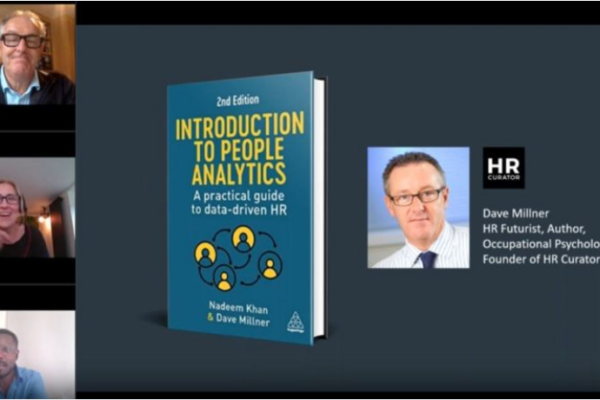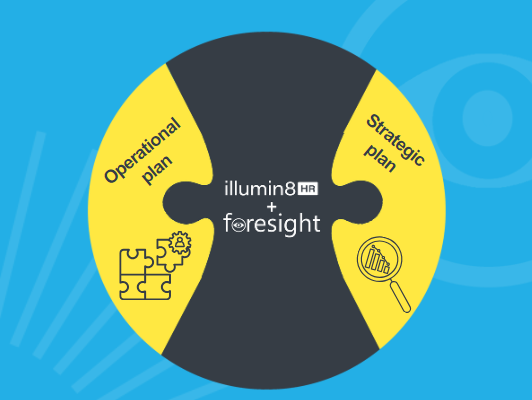5 min ⏱︎
Our Managing Director, Heidi Lopez, recently had the pleasure of sitting down with Dave Millner, HR consultant and people analytics guru, for an in-depth conversation at our latest webinar.
With references and anecdotes from his book, ‘Introduction to People Analytics’, Dave shared his knowledge around the fundamentals of people analytics, and how HR functions become more data driven, data literature and more prevalent in their approach.
Here are five of the top takeaways from Heidi and Dave’s conversation.
“Less is more… focus on the priorities that are going to make an impact.”
1.Focus, prioritisation and impact
When it comes to data and reporting onwards to business leaders, less is more.
As HR teams, we need to understand the business priorities to capture the attention of the relevant business leads. What are the top 3 or 5 things the leadership team need to know about this month? Just because you did it last month, doesn’t mean these are same things you need to know about this month.
Take the same approach with your operational managers – to get them engaging with people analytics, give them something clear and relevant that is going to highlight an action for improvement, and have the biggest impact on their area of the organisation.
“HR’s credibility relies on getting this right.”
2. Be brave!
Dave expresses the need for HR professionals to develop courage in these situations. More ‘digital’ means more data, so as time goes on it’s becoming more challenging than ever to pick out what’s business critical. Avoid 100s of slides or dashboards and be prepared to leave out the detail.
Be brave enough to make decisions around what specific dashboards and insights should be shared with which leaders and at which time. If we can begin to have courage and confidence, we’ll show greater commercial value and have greater impact on the business, and in turn, gain more credibility and investment in the HR function.
“Interpreting the data and creating a clear picture from it is business critical.”
3. Storytelling
Metrics and data are a very important piece of the puzzle, but we need to begin to manage and facilitate their application in a smarter way. This is where storytelling comes in.
Don’t get too wrapped up in percentages and instead consider the real people being represented. Dave shared an example of a company whose survey results showed a high percentage of employees felt their ideas were listened to – until he challenged that also meant several thousand employees felt there were not.
Telling a story with our data makes it actionable and relevant for team leaders and the decisions they are trying to make. Create a clear message with a set of recommendations and the likely business outcomes for those we are relaying the information to. To do this effectively, we must adapt our language.
In one of Dave’s examples, he talks about the ROI from L&D programmes, not just in the context of upskilling individuals, but also in the context of how it might impact sales performance, productivity and customer NPS.
“The best people analytics groups are great collaborators.”
4. Drive change through collaboration
Dave emphasises that ‘people analytics is a change programme’, with a mission to change the way HR thinks and operates, and the way managers and leaders can make decisions. Addressing the culture within the organisation is critical. As HR teams, we have an educational responsibility.
Sharing an example from the British Heart Foundation, Dave explained how they addressed the culture shift with a significant focus on collaboration between HR, leaders and managers. They collaborated to uncover priorities and discover how they could implement data and operate differently in a very organised, structured and focused way.
For some organisations, a more project-based approach to people analytics may be required where the focus is on solving a specific business need or delivering a high priority programme but still provides the opportunity to use HR data to measure outcomes and commercial value.
The culture piece is all about collaboration and having good connections with stakeholders across the organisation, including your HR specialists, HR business partners and the people analytics champions within your organisations.
“Focus on tomorrow, rather than wasting time looking back at yesterday.”
5. The Three D’s
In Dave’s view based on experience of consulting for many different organisations, everything people wanted to do fell into three categories – Data, Digital and Design.
The first one, unsurprisingly is Data. Everyone is interested in data and using it to advance their business goals. Analytics, KPIs and metrics provide the foundations that enable you to take people analytics forward appropriately.
The pandemic brought the second D – Digital – to life, with people having to rely more and more on technology. Technology is an enabler and as the number of HR-related systems grow, HR departments need a digital platform to bring all the data together.
illumin8HR is a great example of this: uniting data across multiple systems into one user-friendly platform making it quick and easy for HR teams and people managers to access and understand their data, make more informed decisions and take action in a timely way.
Which leads us on to the third D – Design. For HR to become more strategic, we need to get closer to the imperatives the business is looking to achieve in the future and what this means for our future workforce – for example, productivity, culture by design, scenario planning, how we design work, the use of AI, succession planning, the skills and competencies needed to deliver the plan.
6. Artificial Intelligence
AI is the latest buzzword, and it’s tempting to jump straight on the bandwagon. However, Dave raises the need to remain slightly risk averse when utilising these tools in HR.
We need to investigate to make sure that AI or machine learning tools are based on appropriate data. There are some questions that should be asked before implementing such a tool, including the size of the data type, the source of the data, and whether it’s coming from the same sector as your organisation. There are a whole host of data complications to think about.
AI can do many things effectively, but we need to ensure it’s being done in a way that reflects your organisation’s culture and way of operating.
Dave provided an insightful delve into the key areas of consideration for HR when implementing people analytics into their organisation. To learn more, watch the full webinar recording here.
If you’d like to discuss our people analytics platform, illumin8HR further, please get in touch here.




